Data Collection and Analysis for Backup and Disaster Recovery Plan
VerifiedAdded on 2023/06/15
|15
|2491
|194
Report
AI Summary
This report presents a data collection and analysis for a backup and disaster recovery plan. The primary data was collected through an online survey with professionals in the field. The analysis uses quantitative methods to interpret the survey responses, focusing on aspects like the existence and review frequency of backup plans, backup system implementation, restore testing, backup frequency, data storage locations, and recovery plans. The report includes charts illustrating the percentage of responses for each survey question. Additionally, it compares the backup and disaster recovery approaches of three companies: Apple, Amazon, and BestBuy. The report also discusses inclusion and exclusion methods for creating backup sets and data recovery. Improvements made to previously submitted papers are highlighted, specifically in the research methodology and literature review sections.
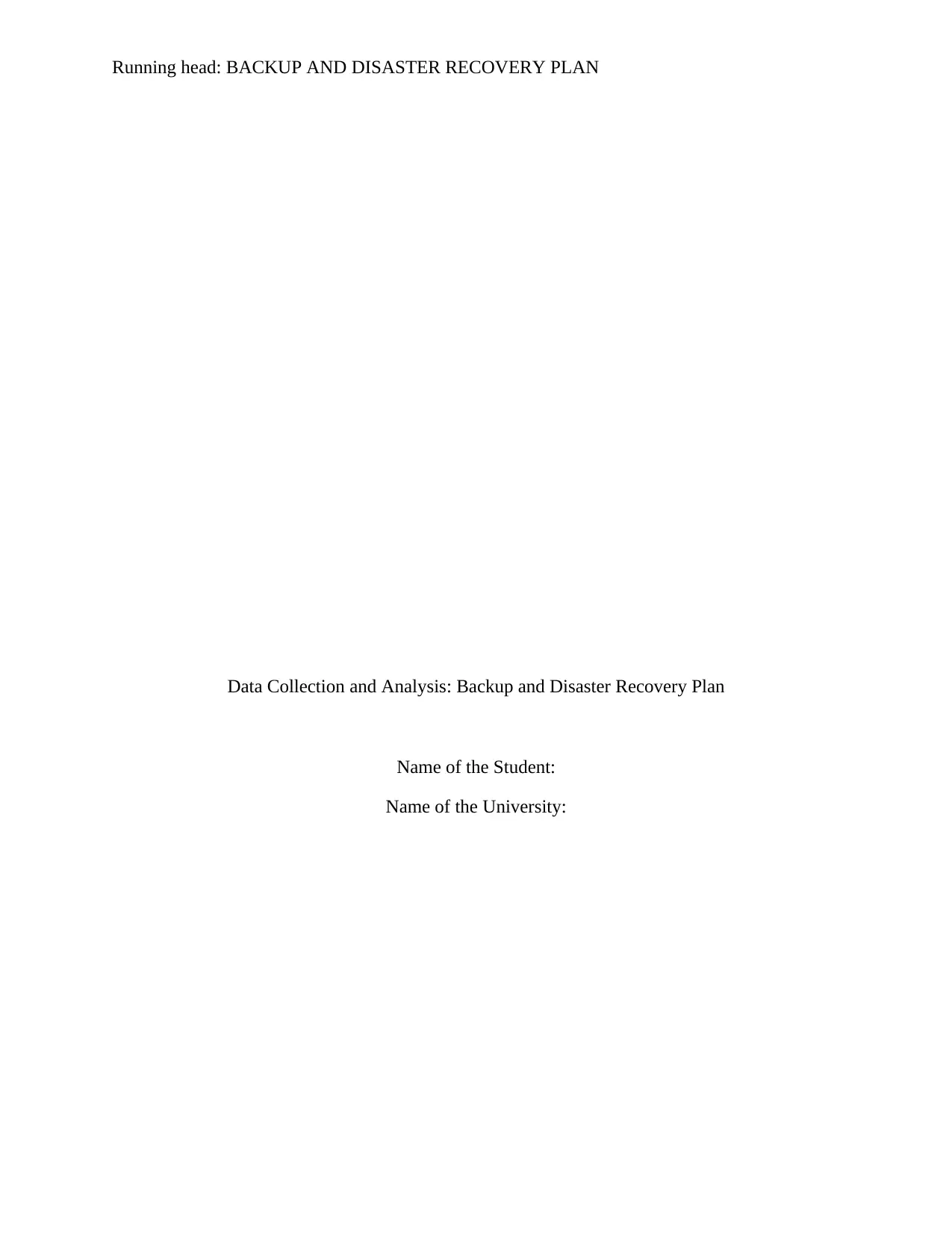
Running head: BACKUP AND DISASTER RECOVERY PLAN
Data Collection and Analysis: Backup and Disaster Recovery Plan
Name of the Student:
Name of the University:
Data Collection and Analysis: Backup and Disaster Recovery Plan
Name of the Student:
Name of the University:
Paraphrase This Document
Need a fresh take? Get an instant paraphrase of this document with our AI Paraphraser
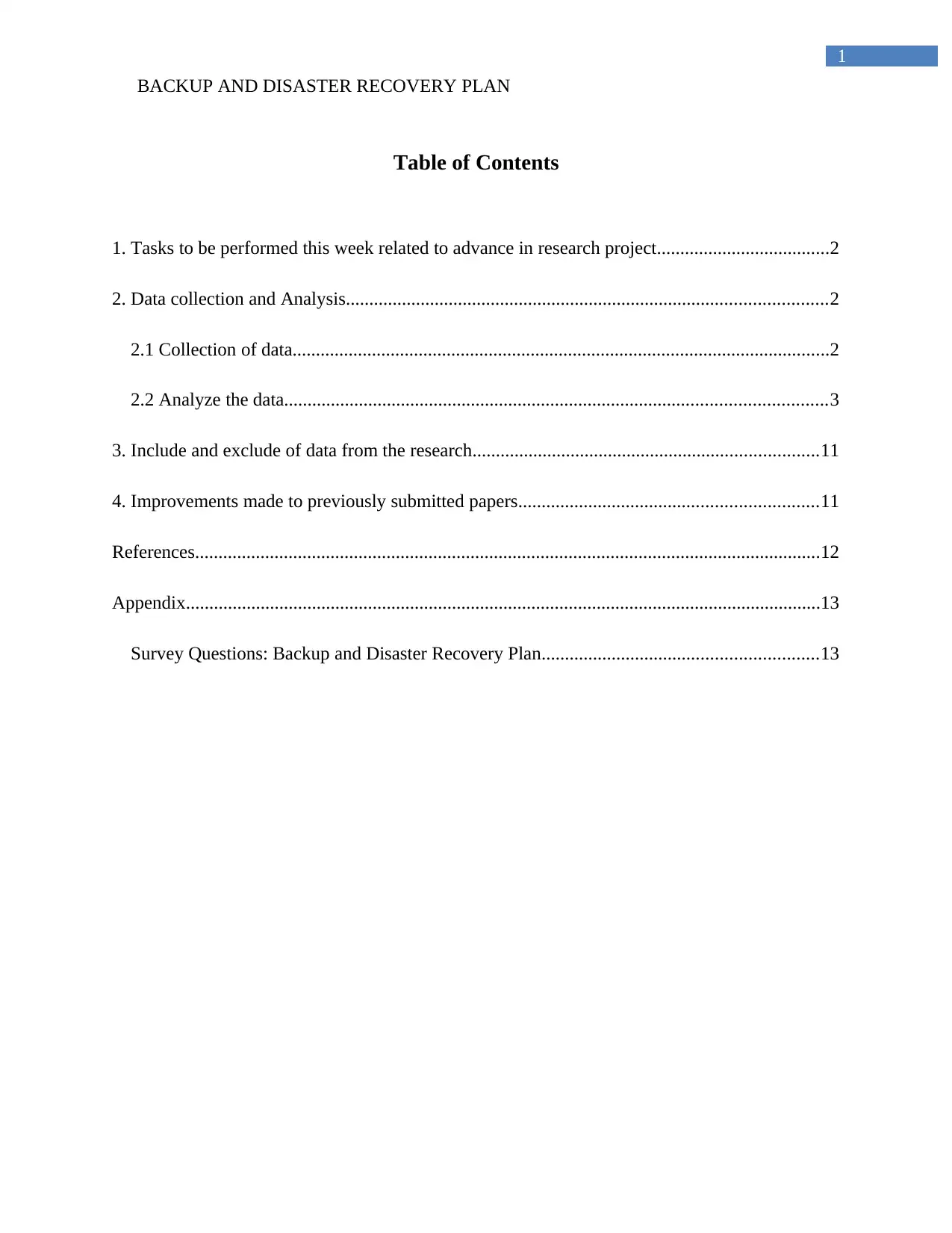
1
BACKUP AND DISASTER RECOVERY PLAN
Table of Contents
1. Tasks to be performed this week related to advance in research project.....................................2
2. Data collection and Analysis.......................................................................................................2
2.1 Collection of data...................................................................................................................2
2.2 Analyze the data....................................................................................................................3
3. Include and exclude of data from the research..........................................................................11
4. Improvements made to previously submitted papers................................................................11
References......................................................................................................................................12
Appendix........................................................................................................................................13
Survey Questions: Backup and Disaster Recovery Plan...........................................................13
BACKUP AND DISASTER RECOVERY PLAN
Table of Contents
1. Tasks to be performed this week related to advance in research project.....................................2
2. Data collection and Analysis.......................................................................................................2
2.1 Collection of data...................................................................................................................2
2.2 Analyze the data....................................................................................................................3
3. Include and exclude of data from the research..........................................................................11
4. Improvements made to previously submitted papers................................................................11
References......................................................................................................................................12
Appendix........................................................................................................................................13
Survey Questions: Backup and Disaster Recovery Plan...........................................................13
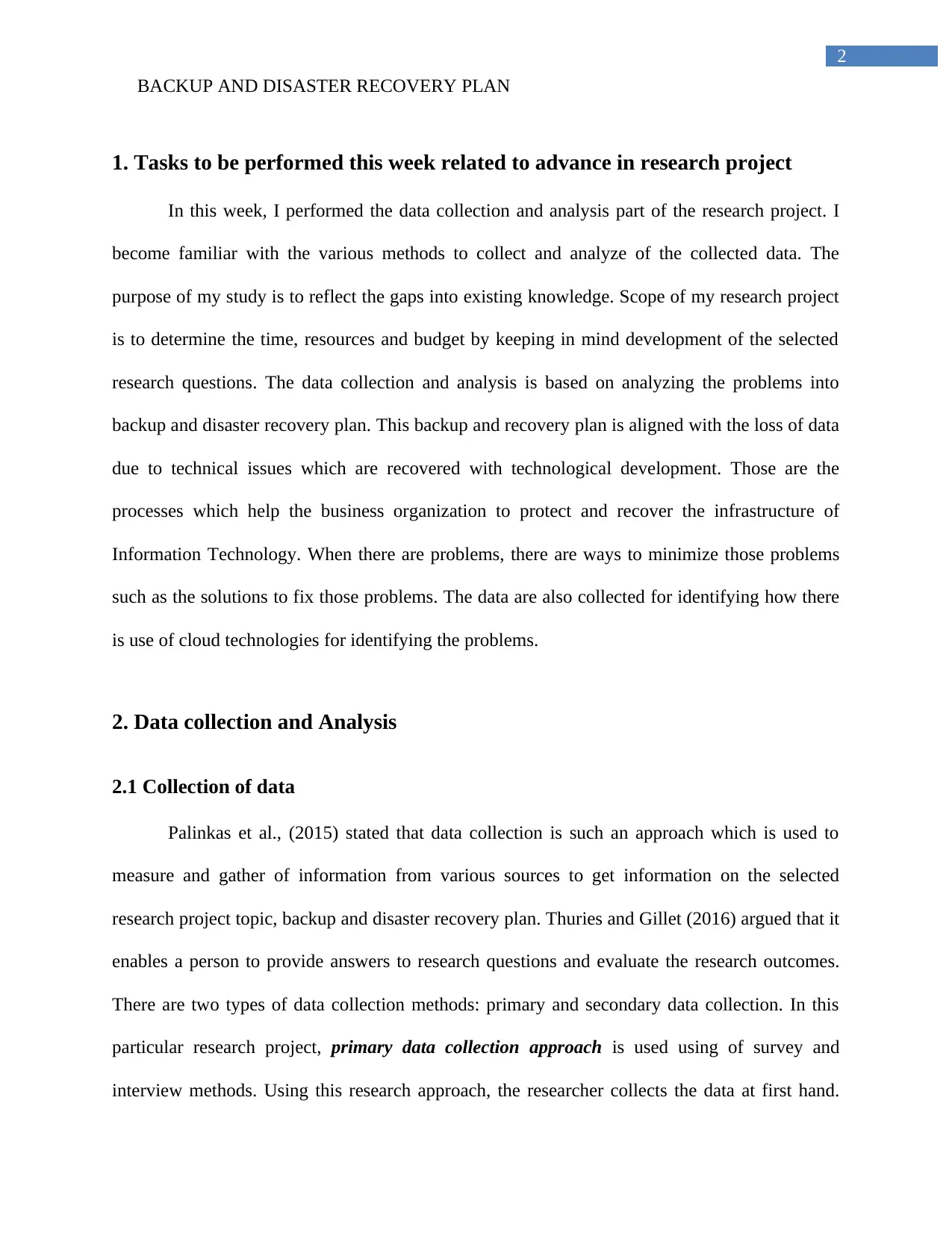
2
BACKUP AND DISASTER RECOVERY PLAN
1. Tasks to be performed this week related to advance in research project
In this week, I performed the data collection and analysis part of the research project. I
become familiar with the various methods to collect and analyze of the collected data. The
purpose of my study is to reflect the gaps into existing knowledge. Scope of my research project
is to determine the time, resources and budget by keeping in mind development of the selected
research questions. The data collection and analysis is based on analyzing the problems into
backup and disaster recovery plan. This backup and recovery plan is aligned with the loss of data
due to technical issues which are recovered with technological development. Those are the
processes which help the business organization to protect and recover the infrastructure of
Information Technology. When there are problems, there are ways to minimize those problems
such as the solutions to fix those problems. The data are also collected for identifying how there
is use of cloud technologies for identifying the problems.
2. Data collection and Analysis
2.1 Collection of data
Palinkas et al., (2015) stated that data collection is such an approach which is used to
measure and gather of information from various sources to get information on the selected
research project topic, backup and disaster recovery plan. Thuries and Gillet (2016) argued that it
enables a person to provide answers to research questions and evaluate the research outcomes.
There are two types of data collection methods: primary and secondary data collection. In this
particular research project, primary data collection approach is used using of survey and
interview methods. Using this research approach, the researcher collects the data at first hand.
BACKUP AND DISASTER RECOVERY PLAN
1. Tasks to be performed this week related to advance in research project
In this week, I performed the data collection and analysis part of the research project. I
become familiar with the various methods to collect and analyze of the collected data. The
purpose of my study is to reflect the gaps into existing knowledge. Scope of my research project
is to determine the time, resources and budget by keeping in mind development of the selected
research questions. The data collection and analysis is based on analyzing the problems into
backup and disaster recovery plan. This backup and recovery plan is aligned with the loss of data
due to technical issues which are recovered with technological development. Those are the
processes which help the business organization to protect and recover the infrastructure of
Information Technology. When there are problems, there are ways to minimize those problems
such as the solutions to fix those problems. The data are also collected for identifying how there
is use of cloud technologies for identifying the problems.
2. Data collection and Analysis
2.1 Collection of data
Palinkas et al., (2015) stated that data collection is such an approach which is used to
measure and gather of information from various sources to get information on the selected
research project topic, backup and disaster recovery plan. Thuries and Gillet (2016) argued that it
enables a person to provide answers to research questions and evaluate the research outcomes.
There are two types of data collection methods: primary and secondary data collection. In this
particular research project, primary data collection approach is used using of survey and
interview methods. Using this research approach, the researcher collects the data at first hand.
⊘ This is a preview!⊘
Do you want full access?
Subscribe today to unlock all pages.

Trusted by 1+ million students worldwide
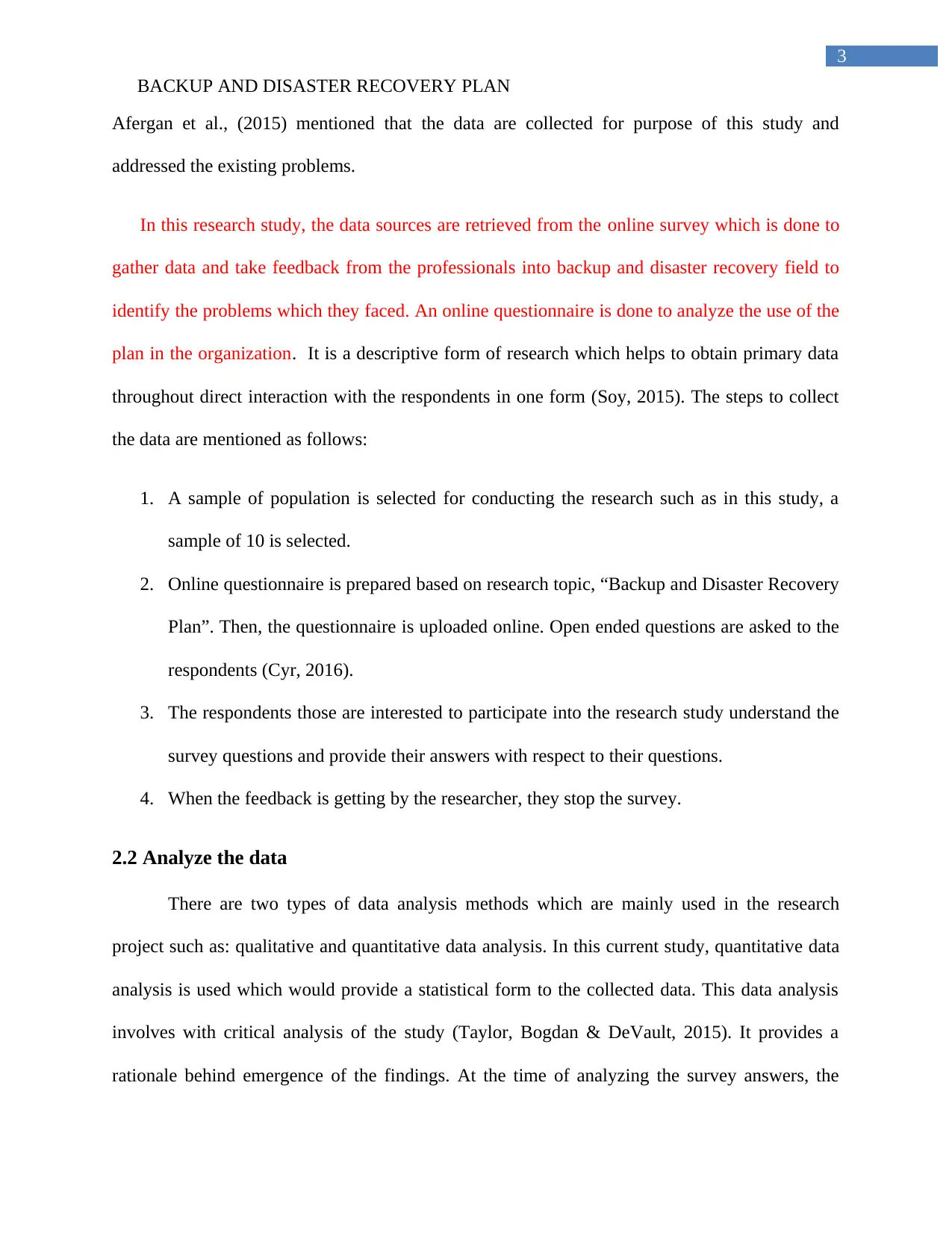
3
BACKUP AND DISASTER RECOVERY PLAN
Afergan et al., (2015) mentioned that the data are collected for purpose of this study and
addressed the existing problems.
In this research study, the data sources are retrieved from the online survey which is done to
gather data and take feedback from the professionals into backup and disaster recovery field to
identify the problems which they faced. An online questionnaire is done to analyze the use of the
plan in the organization. It is a descriptive form of research which helps to obtain primary data
throughout direct interaction with the respondents in one form (Soy, 2015). The steps to collect
the data are mentioned as follows:
1. A sample of population is selected for conducting the research such as in this study, a
sample of 10 is selected.
2. Online questionnaire is prepared based on research topic, “Backup and Disaster Recovery
Plan”. Then, the questionnaire is uploaded online. Open ended questions are asked to the
respondents (Cyr, 2016).
3. The respondents those are interested to participate into the research study understand the
survey questions and provide their answers with respect to their questions.
4. When the feedback is getting by the researcher, they stop the survey.
2.2 Analyze the data
There are two types of data analysis methods which are mainly used in the research
project such as: qualitative and quantitative data analysis. In this current study, quantitative data
analysis is used which would provide a statistical form to the collected data. This data analysis
involves with critical analysis of the study (Taylor, Bogdan & DeVault, 2015). It provides a
rationale behind emergence of the findings. At the time of analyzing the survey answers, the
BACKUP AND DISASTER RECOVERY PLAN
Afergan et al., (2015) mentioned that the data are collected for purpose of this study and
addressed the existing problems.
In this research study, the data sources are retrieved from the online survey which is done to
gather data and take feedback from the professionals into backup and disaster recovery field to
identify the problems which they faced. An online questionnaire is done to analyze the use of the
plan in the organization. It is a descriptive form of research which helps to obtain primary data
throughout direct interaction with the respondents in one form (Soy, 2015). The steps to collect
the data are mentioned as follows:
1. A sample of population is selected for conducting the research such as in this study, a
sample of 10 is selected.
2. Online questionnaire is prepared based on research topic, “Backup and Disaster Recovery
Plan”. Then, the questionnaire is uploaded online. Open ended questions are asked to the
respondents (Cyr, 2016).
3. The respondents those are interested to participate into the research study understand the
survey questions and provide their answers with respect to their questions.
4. When the feedback is getting by the researcher, they stop the survey.
2.2 Analyze the data
There are two types of data analysis methods which are mainly used in the research
project such as: qualitative and quantitative data analysis. In this current study, quantitative data
analysis is used which would provide a statistical form to the collected data. This data analysis
involves with critical analysis of the study (Taylor, Bogdan & DeVault, 2015). It provides a
rationale behind emergence of the findings. At the time of analyzing the survey answers, the
Paraphrase This Document
Need a fresh take? Get an instant paraphrase of this document with our AI Paraphraser
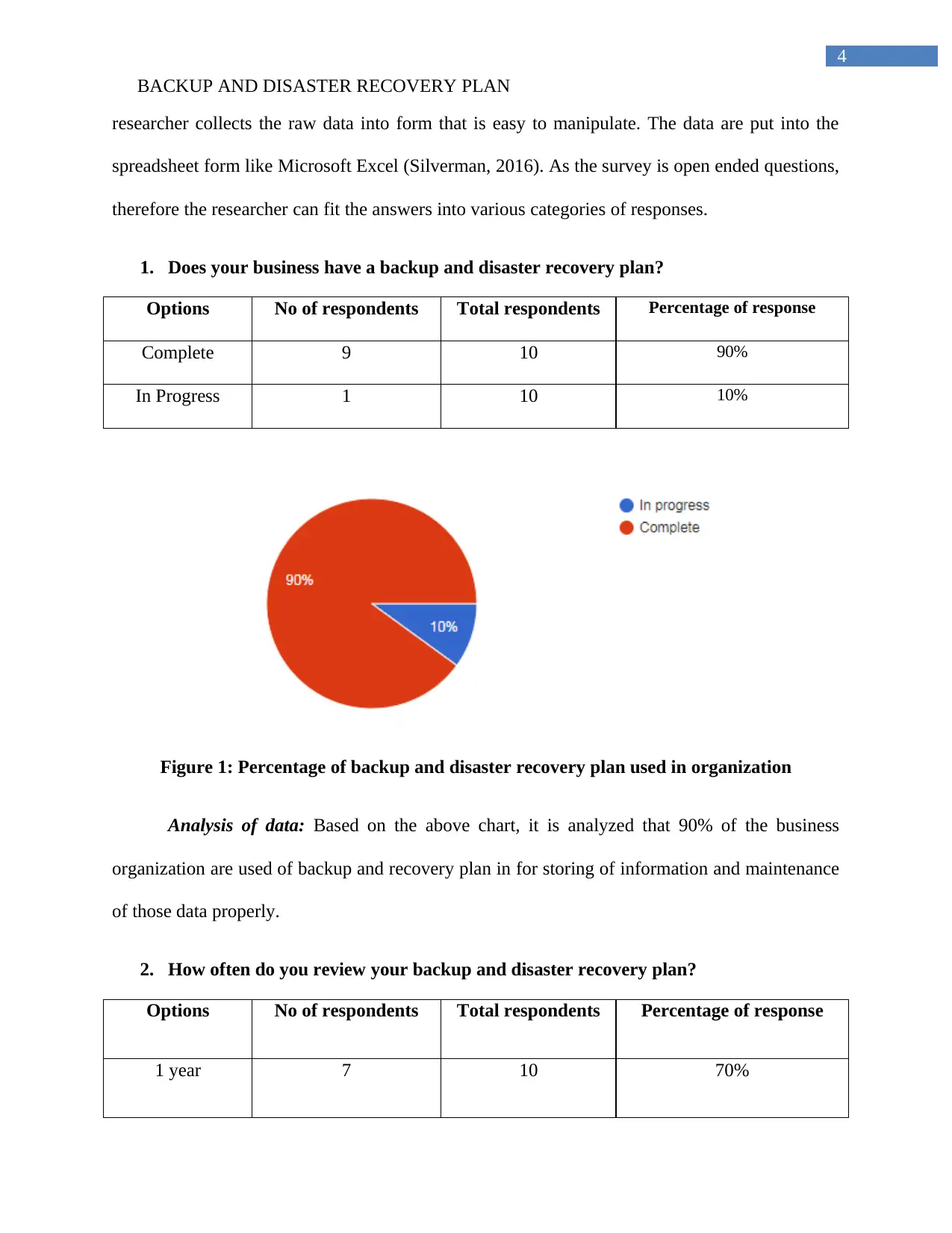
4
BACKUP AND DISASTER RECOVERY PLAN
researcher collects the raw data into form that is easy to manipulate. The data are put into the
spreadsheet form like Microsoft Excel (Silverman, 2016). As the survey is open ended questions,
therefore the researcher can fit the answers into various categories of responses.
1. Does your business have a backup and disaster recovery plan?
Options No of respondents Total respondents Percentage of response
Complete 9 10 90%
In Progress 1 10 10%
Figure 1: Percentage of backup and disaster recovery plan used in organization
Analysis of data: Based on the above chart, it is analyzed that 90% of the business
organization are used of backup and recovery plan in for storing of information and maintenance
of those data properly.
2. How often do you review your backup and disaster recovery plan?
Options No of respondents Total respondents Percentage of response
1 year 7 10 70%
BACKUP AND DISASTER RECOVERY PLAN
researcher collects the raw data into form that is easy to manipulate. The data are put into the
spreadsheet form like Microsoft Excel (Silverman, 2016). As the survey is open ended questions,
therefore the researcher can fit the answers into various categories of responses.
1. Does your business have a backup and disaster recovery plan?
Options No of respondents Total respondents Percentage of response
Complete 9 10 90%
In Progress 1 10 10%
Figure 1: Percentage of backup and disaster recovery plan used in organization
Analysis of data: Based on the above chart, it is analyzed that 90% of the business
organization are used of backup and recovery plan in for storing of information and maintenance
of those data properly.
2. How often do you review your backup and disaster recovery plan?
Options No of respondents Total respondents Percentage of response
1 year 7 10 70%

5
BACKUP AND DISASTER RECOVERY PLAN
2 years 2 10 20%
Never 0 10 0%
No plan 1 10 10%
Figure 2: Time to review the backup and disaster recovery plan
Analysis of data: From the above chart, it is analyzed that 70% of the respondents review
their plan on 1 year of gap. Only 10% have no such backup and recovery plan in their business to
restore the data for future purposes. Each of the backup and disaster recovery plan requires
update and review to determine if any changes are occurred. Review of the plan saves the money
of the organization and improves the organizational performance to analyze the technical issues.
3. Does your organization have any backup system for the purpose of information
record?
Options No of respondents Total respondents Percentage of response
Yes 8 10 80%
In Progress 1 10 10%
No 1 10 10%
BACKUP AND DISASTER RECOVERY PLAN
2 years 2 10 20%
Never 0 10 0%
No plan 1 10 10%
Figure 2: Time to review the backup and disaster recovery plan
Analysis of data: From the above chart, it is analyzed that 70% of the respondents review
their plan on 1 year of gap. Only 10% have no such backup and recovery plan in their business to
restore the data for future purposes. Each of the backup and disaster recovery plan requires
update and review to determine if any changes are occurred. Review of the plan saves the money
of the organization and improves the organizational performance to analyze the technical issues.
3. Does your organization have any backup system for the purpose of information
record?
Options No of respondents Total respondents Percentage of response
Yes 8 10 80%
In Progress 1 10 10%
No 1 10 10%
⊘ This is a preview!⊘
Do you want full access?
Subscribe today to unlock all pages.

Trusted by 1+ million students worldwide
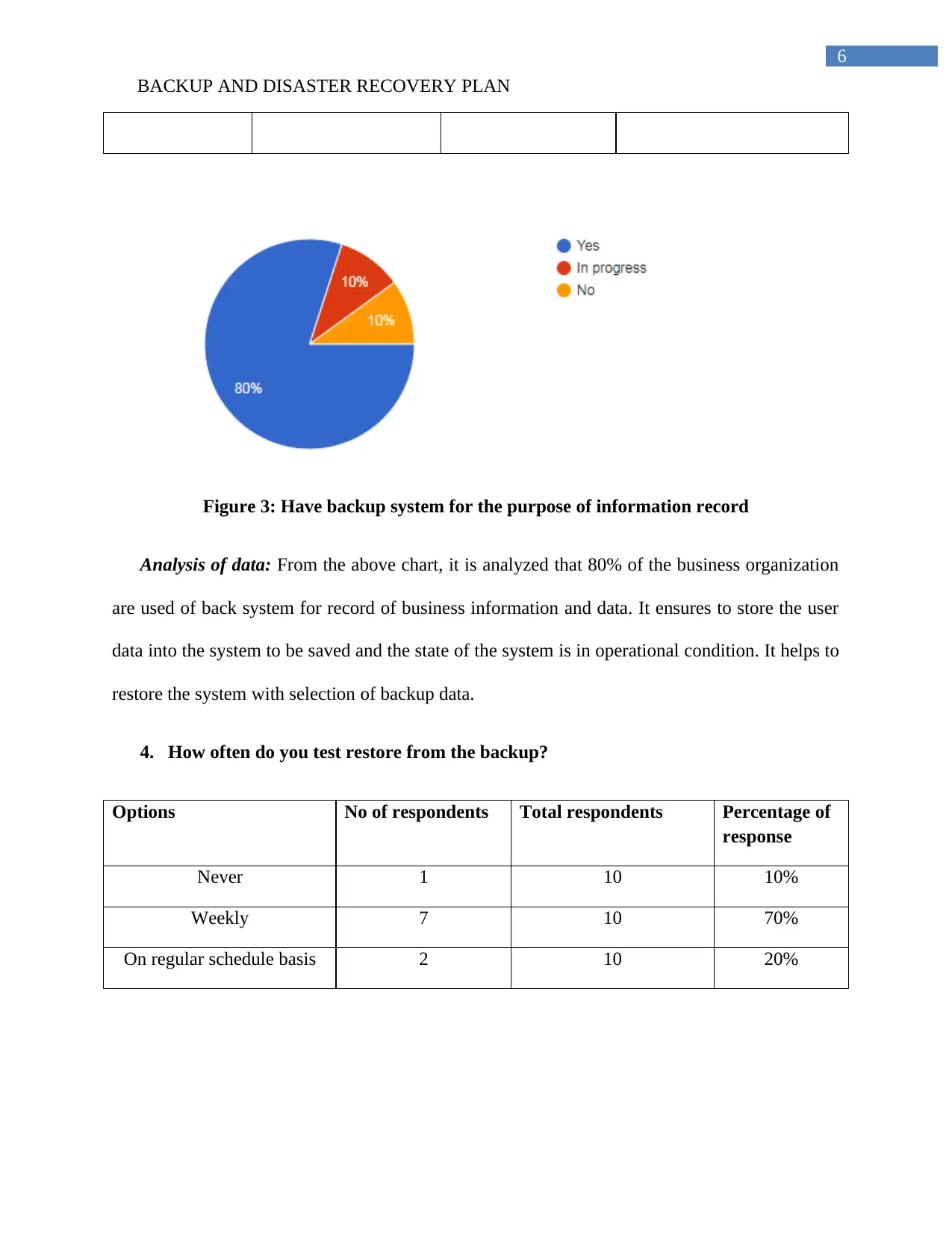
6
BACKUP AND DISASTER RECOVERY PLAN
Figure 3: Have backup system for the purpose of information record
Analysis of data: From the above chart, it is analyzed that 80% of the business organization
are used of back system for record of business information and data. It ensures to store the user
data into the system to be saved and the state of the system is in operational condition. It helps to
restore the system with selection of backup data.
4. How often do you test restore from the backup?
Options No of respondents Total respondents Percentage of
response
Never 1 10 10%
Weekly 7 10 70%
On regular schedule basis 2 10 20%
BACKUP AND DISASTER RECOVERY PLAN
Figure 3: Have backup system for the purpose of information record
Analysis of data: From the above chart, it is analyzed that 80% of the business organization
are used of back system for record of business information and data. It ensures to store the user
data into the system to be saved and the state of the system is in operational condition. It helps to
restore the system with selection of backup data.
4. How often do you test restore from the backup?
Options No of respondents Total respondents Percentage of
response
Never 1 10 10%
Weekly 7 10 70%
On regular schedule basis 2 10 20%
Paraphrase This Document
Need a fresh take? Get an instant paraphrase of this document with our AI Paraphraser
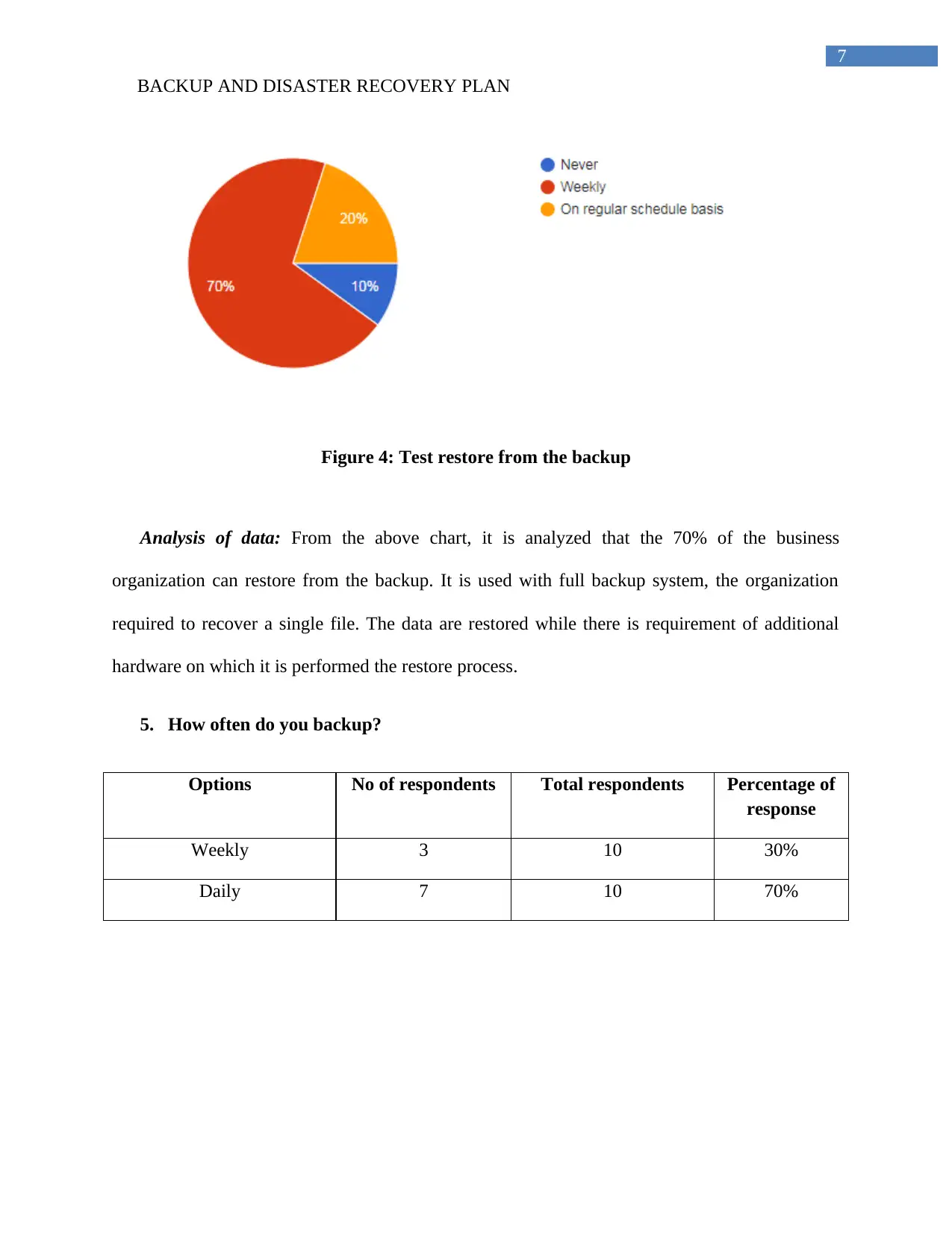
7
BACKUP AND DISASTER RECOVERY PLAN
Figure 4: Test restore from the backup
Analysis of data: From the above chart, it is analyzed that the 70% of the business
organization can restore from the backup. It is used with full backup system, the organization
required to recover a single file. The data are restored while there is requirement of additional
hardware on which it is performed the restore process.
5. How often do you backup?
Options No of respondents Total respondents Percentage of
response
Weekly 3 10 30%
Daily 7 10 70%
BACKUP AND DISASTER RECOVERY PLAN
Figure 4: Test restore from the backup
Analysis of data: From the above chart, it is analyzed that the 70% of the business
organization can restore from the backup. It is used with full backup system, the organization
required to recover a single file. The data are restored while there is requirement of additional
hardware on which it is performed the restore process.
5. How often do you backup?
Options No of respondents Total respondents Percentage of
response
Weekly 3 10 30%
Daily 7 10 70%
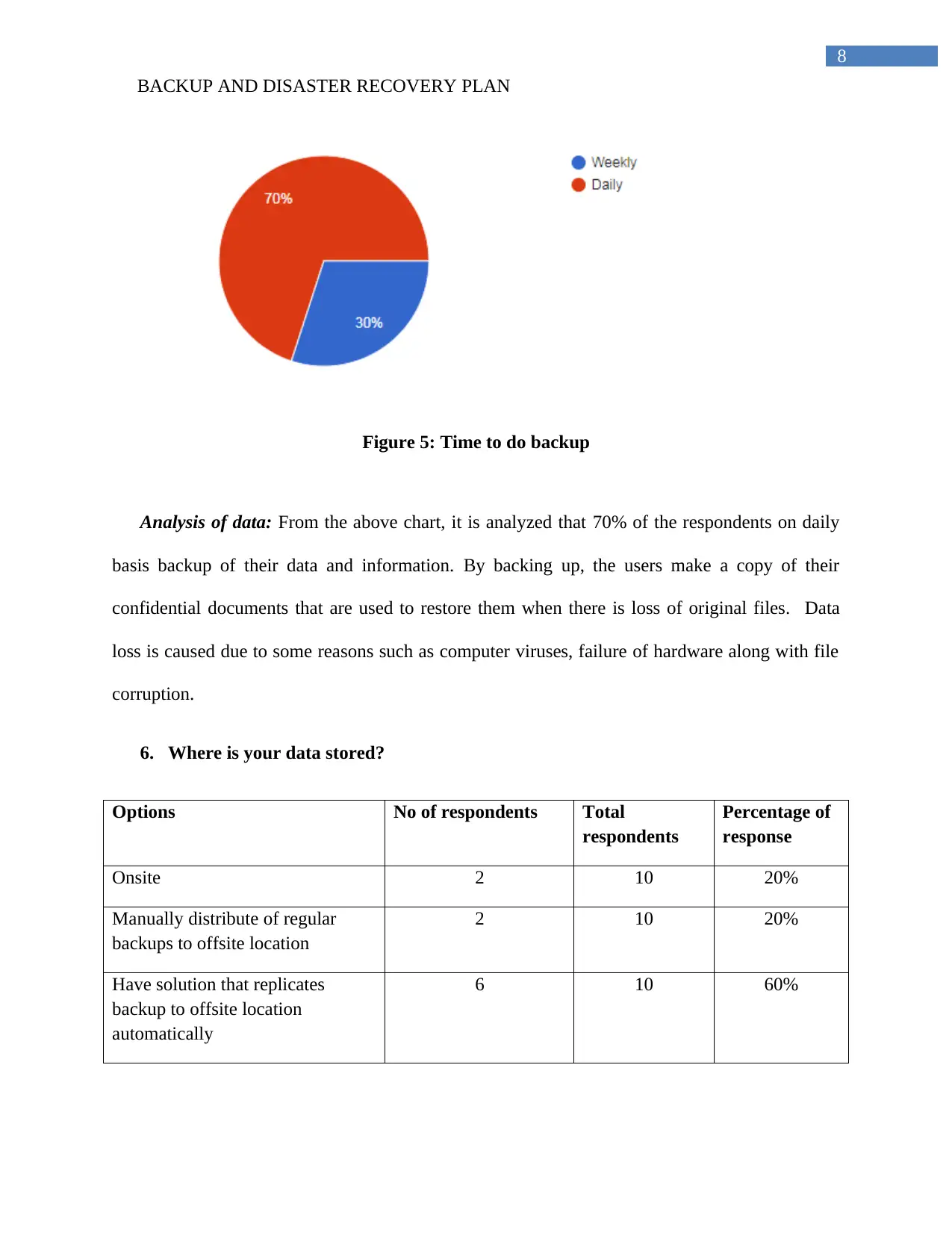
8
BACKUP AND DISASTER RECOVERY PLAN
Figure 5: Time to do backup
Analysis of data: From the above chart, it is analyzed that 70% of the respondents on daily
basis backup of their data and information. By backing up, the users make a copy of their
confidential documents that are used to restore them when there is loss of original files. Data
loss is caused due to some reasons such as computer viruses, failure of hardware along with file
corruption.
6. Where is your data stored?
Options No of respondents Total
respondents
Percentage of
response
Onsite 2 10 20%
Manually distribute of regular
backups to offsite location
2 10 20%
Have solution that replicates
backup to offsite location
automatically
6 10 60%
BACKUP AND DISASTER RECOVERY PLAN
Figure 5: Time to do backup
Analysis of data: From the above chart, it is analyzed that 70% of the respondents on daily
basis backup of their data and information. By backing up, the users make a copy of their
confidential documents that are used to restore them when there is loss of original files. Data
loss is caused due to some reasons such as computer viruses, failure of hardware along with file
corruption.
6. Where is your data stored?
Options No of respondents Total
respondents
Percentage of
response
Onsite 2 10 20%
Manually distribute of regular
backups to offsite location
2 10 20%
Have solution that replicates
backup to offsite location
automatically
6 10 60%
⊘ This is a preview!⊘
Do you want full access?
Subscribe today to unlock all pages.

Trusted by 1+ million students worldwide
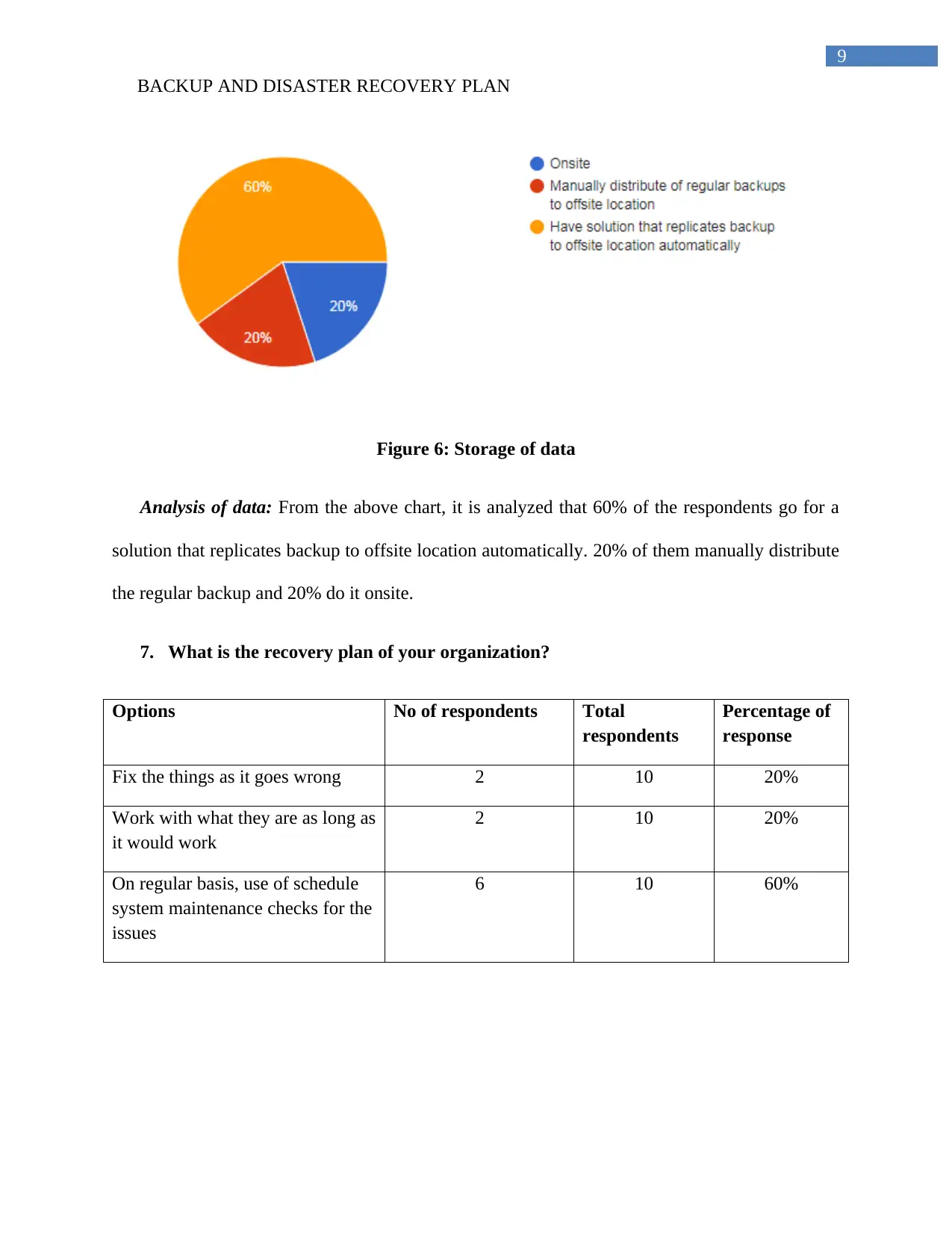
9
BACKUP AND DISASTER RECOVERY PLAN
Figure 6: Storage of data
Analysis of data: From the above chart, it is analyzed that 60% of the respondents go for a
solution that replicates backup to offsite location automatically. 20% of them manually distribute
the regular backup and 20% do it onsite.
7. What is the recovery plan of your organization?
Options No of respondents Total
respondents
Percentage of
response
Fix the things as it goes wrong 2 10 20%
Work with what they are as long as
it would work
2 10 20%
On regular basis, use of schedule
system maintenance checks for the
issues
6 10 60%
BACKUP AND DISASTER RECOVERY PLAN
Figure 6: Storage of data
Analysis of data: From the above chart, it is analyzed that 60% of the respondents go for a
solution that replicates backup to offsite location automatically. 20% of them manually distribute
the regular backup and 20% do it onsite.
7. What is the recovery plan of your organization?
Options No of respondents Total
respondents
Percentage of
response
Fix the things as it goes wrong 2 10 20%
Work with what they are as long as
it would work
2 10 20%
On regular basis, use of schedule
system maintenance checks for the
issues
6 10 60%
Paraphrase This Document
Need a fresh take? Get an instant paraphrase of this document with our AI Paraphraser
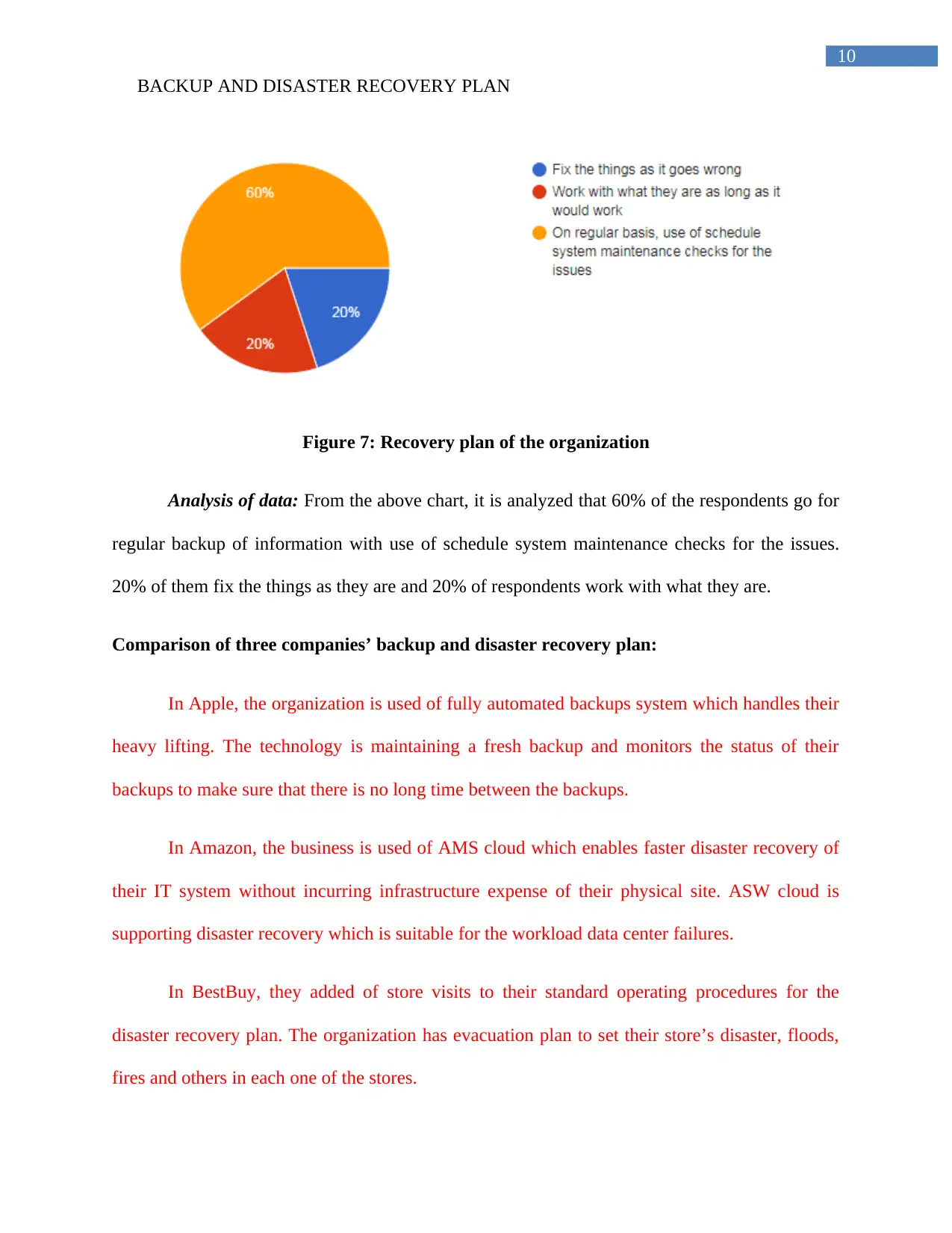
10
BACKUP AND DISASTER RECOVERY PLAN
Figure 7: Recovery plan of the organization
Analysis of data: From the above chart, it is analyzed that 60% of the respondents go for
regular backup of information with use of schedule system maintenance checks for the issues.
20% of them fix the things as they are and 20% of respondents work with what they are.
Comparison of three companies’ backup and disaster recovery plan:
In Apple, the organization is used of fully automated backups system which handles their
heavy lifting. The technology is maintaining a fresh backup and monitors the status of their
backups to make sure that there is no long time between the backups.
In Amazon, the business is used of AMS cloud which enables faster disaster recovery of
their IT system without incurring infrastructure expense of their physical site. ASW cloud is
supporting disaster recovery which is suitable for the workload data center failures.
In BestBuy, they added of store visits to their standard operating procedures for the
disaster recovery plan. The organization has evacuation plan to set their store’s disaster, floods,
fires and others in each one of the stores.
BACKUP AND DISASTER RECOVERY PLAN
Figure 7: Recovery plan of the organization
Analysis of data: From the above chart, it is analyzed that 60% of the respondents go for
regular backup of information with use of schedule system maintenance checks for the issues.
20% of them fix the things as they are and 20% of respondents work with what they are.
Comparison of three companies’ backup and disaster recovery plan:
In Apple, the organization is used of fully automated backups system which handles their
heavy lifting. The technology is maintaining a fresh backup and monitors the status of their
backups to make sure that there is no long time between the backups.
In Amazon, the business is used of AMS cloud which enables faster disaster recovery of
their IT system without incurring infrastructure expense of their physical site. ASW cloud is
supporting disaster recovery which is suitable for the workload data center failures.
In BestBuy, they added of store visits to their standard operating procedures for the
disaster recovery plan. The organization has evacuation plan to set their store’s disaster, floods,
fires and others in each one of the stores.
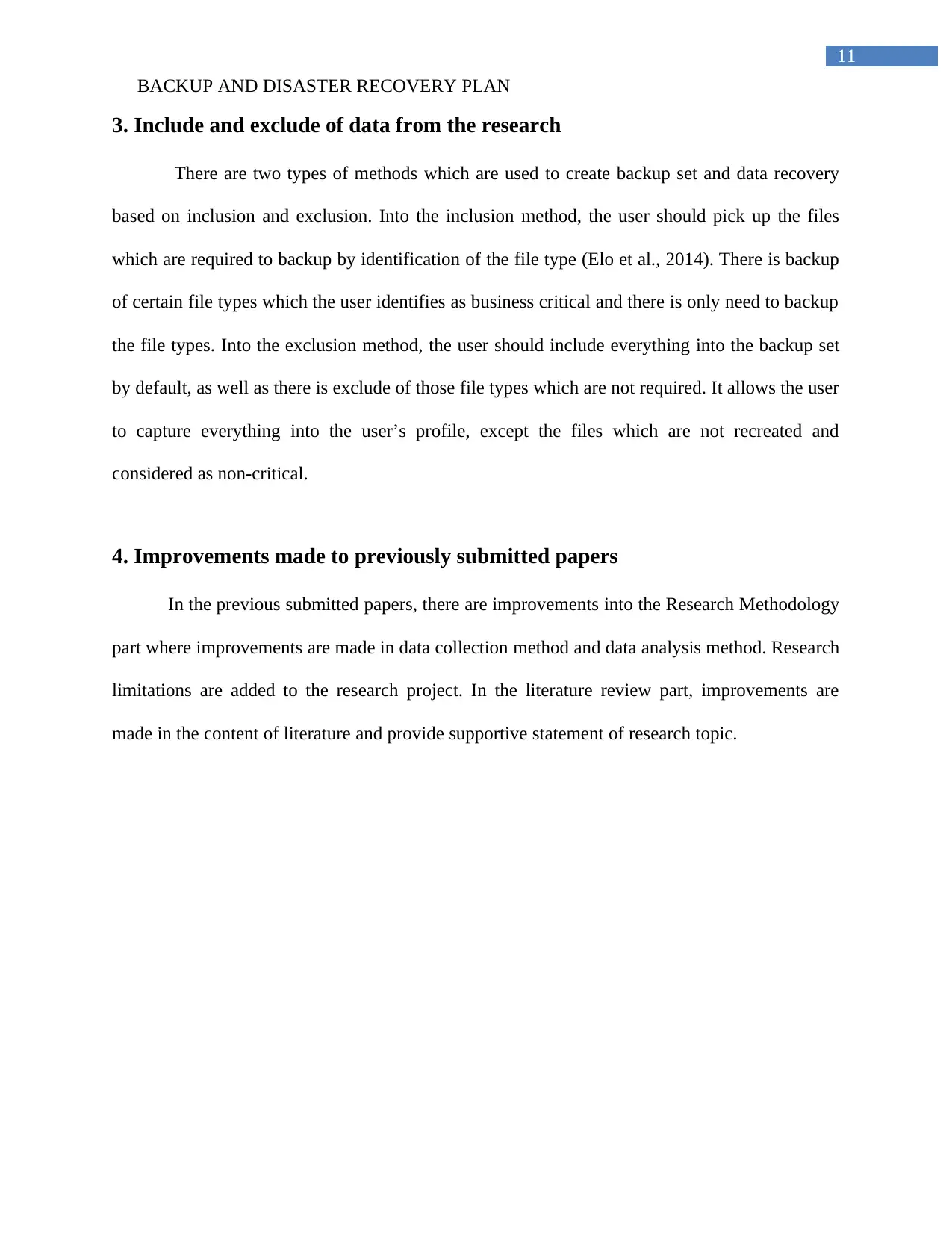
11
BACKUP AND DISASTER RECOVERY PLAN
3. Include and exclude of data from the research
There are two types of methods which are used to create backup set and data recovery
based on inclusion and exclusion. Into the inclusion method, the user should pick up the files
which are required to backup by identification of the file type (Elo et al., 2014). There is backup
of certain file types which the user identifies as business critical and there is only need to backup
the file types. Into the exclusion method, the user should include everything into the backup set
by default, as well as there is exclude of those file types which are not required. It allows the user
to capture everything into the user’s profile, except the files which are not recreated and
considered as non-critical.
4. Improvements made to previously submitted papers
In the previous submitted papers, there are improvements into the Research Methodology
part where improvements are made in data collection method and data analysis method. Research
limitations are added to the research project. In the literature review part, improvements are
made in the content of literature and provide supportive statement of research topic.
BACKUP AND DISASTER RECOVERY PLAN
3. Include and exclude of data from the research
There are two types of methods which are used to create backup set and data recovery
based on inclusion and exclusion. Into the inclusion method, the user should pick up the files
which are required to backup by identification of the file type (Elo et al., 2014). There is backup
of certain file types which the user identifies as business critical and there is only need to backup
the file types. Into the exclusion method, the user should include everything into the backup set
by default, as well as there is exclude of those file types which are not required. It allows the user
to capture everything into the user’s profile, except the files which are not recreated and
considered as non-critical.
4. Improvements made to previously submitted papers
In the previous submitted papers, there are improvements into the Research Methodology
part where improvements are made in data collection method and data analysis method. Research
limitations are added to the research project. In the literature review part, improvements are
made in the content of literature and provide supportive statement of research topic.
⊘ This is a preview!⊘
Do you want full access?
Subscribe today to unlock all pages.

Trusted by 1+ million students worldwide
1 out of 15
Related Documents
Your All-in-One AI-Powered Toolkit for Academic Success.
+13062052269
info@desklib.com
Available 24*7 on WhatsApp / Email
![[object Object]](/_next/static/media/star-bottom.7253800d.svg)
Unlock your academic potential
Copyright © 2020–2025 A2Z Services. All Rights Reserved. Developed and managed by ZUCOL.


